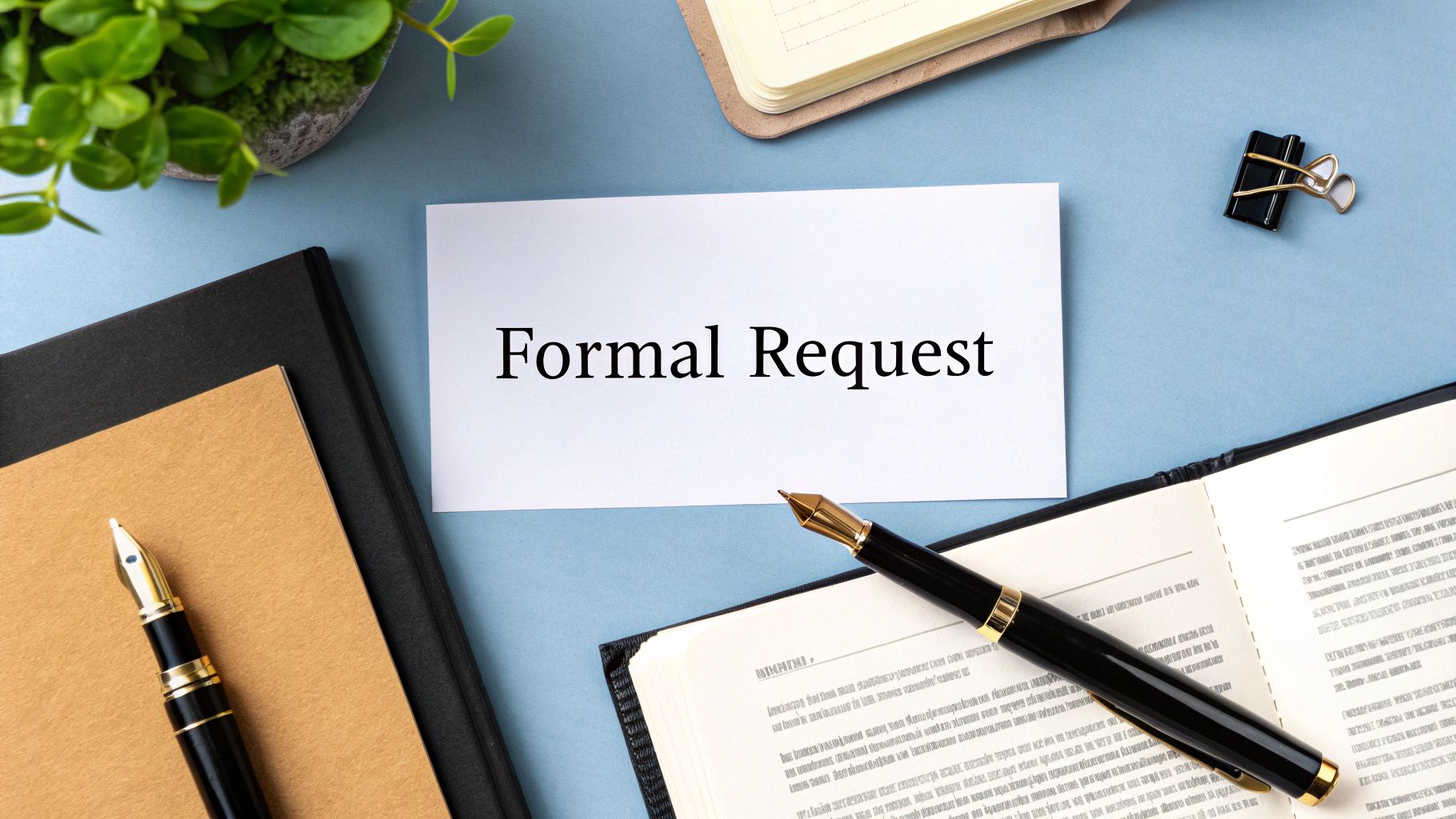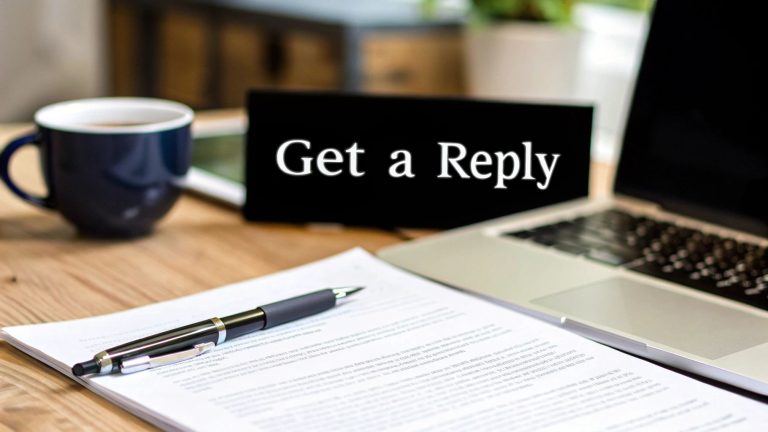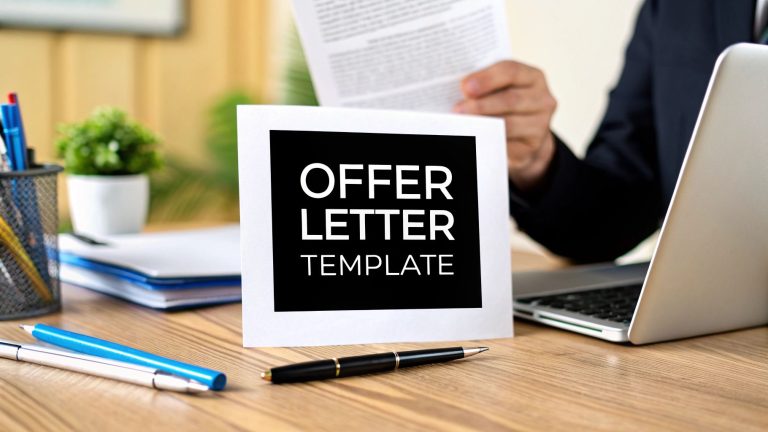Writing a formal request can feel like sending a message in a bottle. You craft it carefully, send it off, and hope for the best. But what if you could turn that hope into a predictable outcome? The secret isn't just politeness; it's structure, strategy, and clarity. A well-written formal request letter commands attention and respect, making it almost impossible to ignore.
It’s the key to securing funding, getting approvals, and opening doors that might otherwise stay closed. This guide breaks down six essential formal request letter examples, providing not just templates, but a deep dive into the strategy behind each one. Just as effective communication is vital in applications, where leveraging proven cover letter examples and templates can significantly improve your chances, the same strategic approach applies here. We'll analyze what works, why it works, and how you can replicate that success every single time.
By the end, you will have the tools to move beyond generic templates and craft compelling, persuasive requests that get results. We will explore requests for a leave of absence, meetings, information, funding, permission, and job transfers, giving you a clear blueprint for each scenario.
1. Leave of Absence Request Letter
A leave of absence request is a formal letter written to an employer to ask for an extended period of time off from work. This type of request is necessary for situations like maternity leave, medical recovery, personal development sabbaticals, or caring for a family member. It serves as an official record for both the employee and HR, ensuring clarity and maintaining a professional relationship.
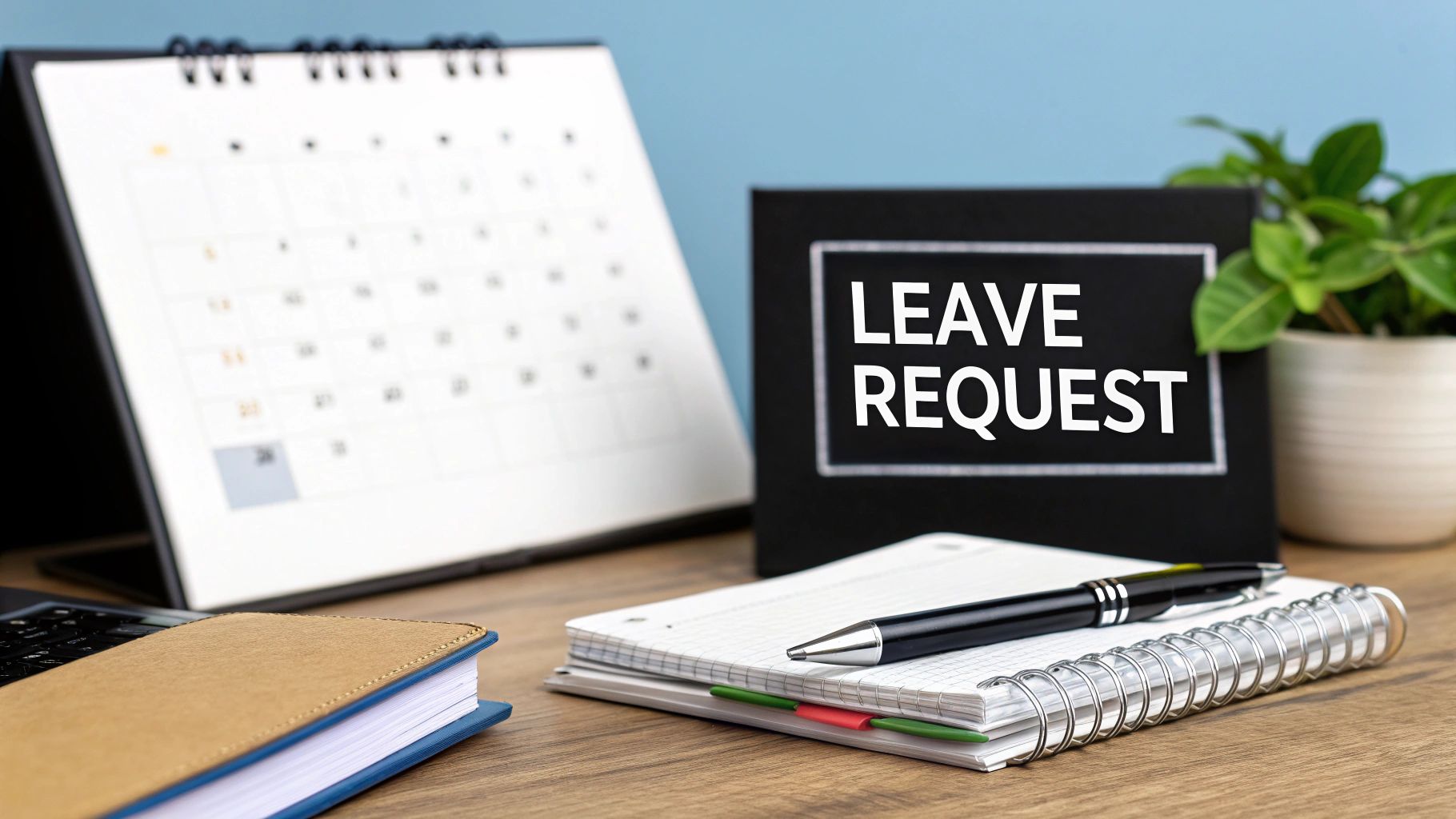
The primary goal is to provide clear, essential information without oversharing personal details. It should state the reason for the leave, the specific start and end dates, and a proactive plan for managing your responsibilities during your absence. This demonstrates foresight and respect for your team's workflow.
When to Use This Letter
This formal request letter example is essential anytime you need to be away from work for an extended period, typically longer than your standard paid time off allowance.
- Medical Leave: For your own serious health condition, surgery, or recovery.
- Family Leave: For the birth or adoption of a child (maternity/paternity leave) or to care for a seriously ill family member.
- Personal Sabbatical: For educational pursuits, professional certifications, or personal growth.
- Bereavement: For extended time needed after the loss of a close family member.
Actionable Tips for a Strong Request
Crafting a professional request increases the likelihood of a smooth approval process. Focus on clarity, timing, and preparedness. To help you craft effective requests, explore expert tips and templates for writing a leave letter that can guide you through the specifics.
Here are key strategies to implement:
- Submit Early: Provide your request at least 30-60 days in advance, whenever possible. This gives your manager ample time to plan for your absence.
- State Dates Clearly: Specify the exact start and end dates of your requested leave. For example, "I would like to request a leave of absence from October 1, 2024, to December 23, 2024."
- Propose a Coverage Plan: Briefly outline how your key duties will be handled. Mention projects you will complete before leaving or colleagues you are training to cover essential tasks.
- Reference Company Policy: If applicable, mention the specific company policy or legal provision (like FMLA) your request falls under. This shows you've done your research.
2. Meeting Request Letter
A meeting request letter is a formal correspondence written to schedule a meeting with an individual or a group, most often used in professional settings. This letter clearly states the purpose of the meeting, suggests a potential agenda, and proposes preferred times and a location. It is a critical tool for professional networking, pitching business ideas, conducting client consultations, or facilitating important internal discussions.

The main objective of this formal request letter example is to secure a meeting by being respectful of the recipient's time and clearly articulating the value of the proposed discussion. It should be concise and persuasive, providing all necessary details to make scheduling simple. This approach demonstrates professionalism and increases the likelihood of a positive response.
When to Use This Letter
A formal meeting request is appropriate whenever you need to secure a dedicated time slot on someone's calendar, especially if they are a busy professional, a potential client, or a senior colleague.
- Sales and Business Development: To request a product demo with a potential client or a partnership discussion with another company.
- Career Management: For an employee to request a performance review or a career development conversation with their supervisor.
- Networking: To ask a subject matter expert or industry leader for an informational interview.
- Entrepreneurship: When seeking a meeting with potential investors to pitch a startup idea.
- Community Engagement: To request a meeting with a local government official to discuss community issues.
Actionable Tips for a Strong Request
A well-crafted meeting request is direct, professional, and considerate. Proper formatting and a clear purpose are key. To ensure your letter is structured correctly, review expert guidance on how to format a professional letter for maximum impact.
Here are key strategies to implement:
- Be Clear and Concise: Immediately state the purpose of the meeting in your opening sentences. A vague request is easy to ignore.
- Explain the Value for Them: Briefly explain why the meeting would be beneficial to the recipient. What problem can you solve for them, or what valuable information can you offer?
- Offer Specific Time Options: Instead of asking, "When are you free?" provide 3-4 specific date and time slots. For example, "Would Tuesday, October 8th at 10:00 AM or Thursday, October 10th at 2:30 PM work for you?"
- Specify the Format and Duration: Clearly state whether the meeting will be in-person, a phone call, or a video conference, and provide an estimated duration (e.g., "a brief 20-minute video call").
- Use a Clear Subject Line (for Email): If sending via email, use a direct subject line like "Meeting Request: Discussing [Topic]" or "Request for a Brief Meeting re: [Project Name]."
3. Information Request Letter
An information request letter is a formal document used to ask for specific data, documents, or details from an organization, institution, or individual. This type of formal request letter is common in professional, academic, and legal contexts, serving as an official means to obtain necessary information that is not publicly available. It establishes a clear, documented record of the request.
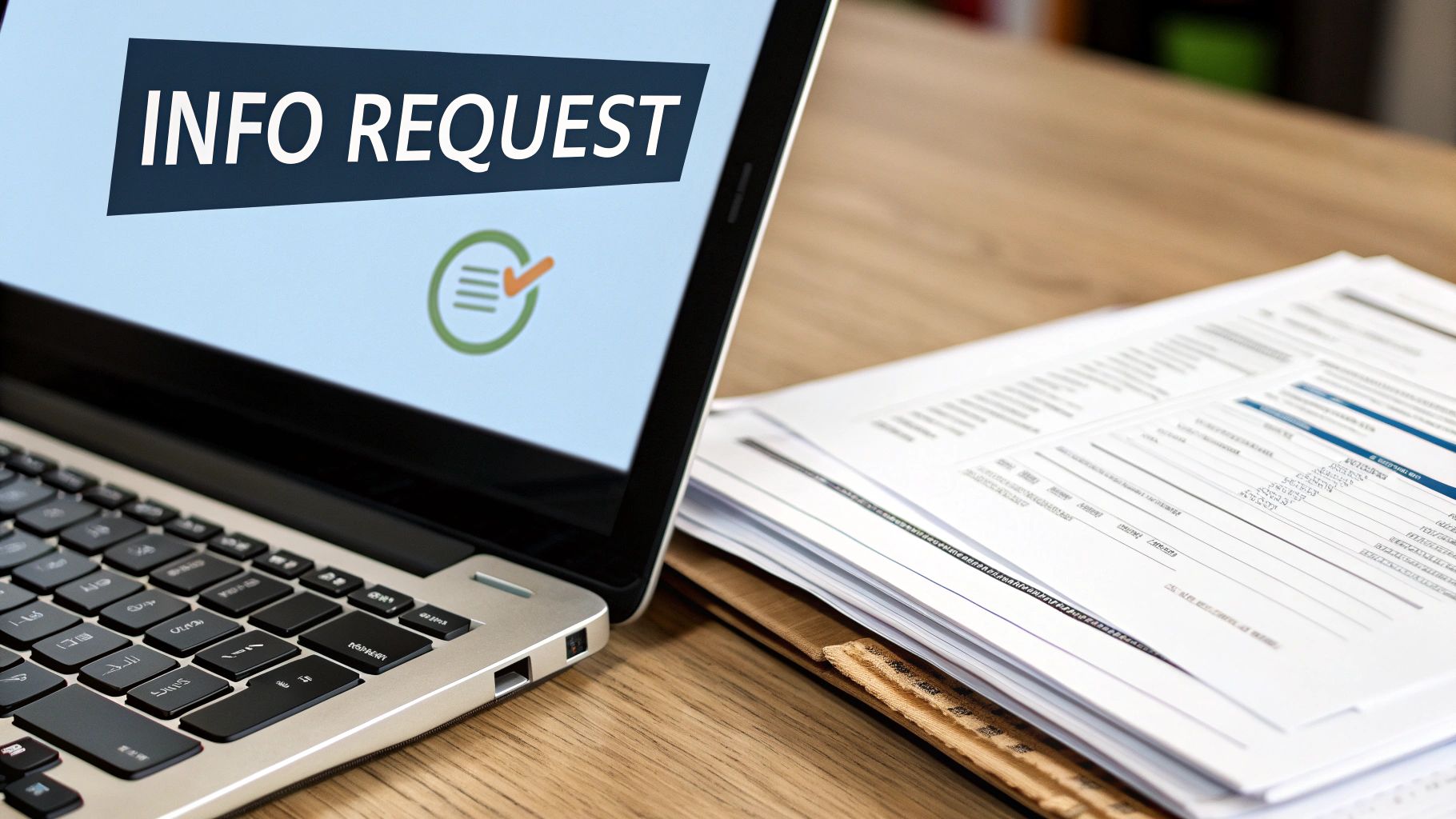
The main purpose of this letter is to articulate precisely what information you need, why you need it, and how you would like to receive it. A well-written request is professional, direct, and provides the recipient with all the necessary context to fulfill it efficiently. It is crucial for tasks like research, due diligence, and exercising legal rights.
When to Use This Letter
This formal request letter example is appropriate whenever you need to officially ask for specific information from an entity that holds it.
- Academic Purposes: A student requesting transcripts from a previous university or a researcher asking a government agency for statistical data.
- Legal Matters: A lawyer requesting a client's medical records for litigation or a journalist filing a Freedom of Information Act (FOIA) request for public records.
- Business Operations: A company requesting detailed product specifications from a supplier or performing due diligence on a potential partner.
- Personal Data: A consumer requesting a copy of their personal data from a company under regulations like GDPR or CCPA.
Actionable Tips for a Strong Request
A clear and well-structured request significantly improves your chances of getting a prompt and accurate response. Precision, context, and a professional tone are your most important tools. For additional guidance, you can find helpful resources on how to write inquiry letters to refine your approach.
Here are key strategies to implement:
- Be Extremely Specific: Clearly list the exact documents, data points, or information you are requesting. Avoid vague terms. For example, instead of "all files related to the project," write "the project proposal, meeting minutes from May 10, 2024, and the final budget report."
- Cite Relevant Authority: If your request is based on a law or regulation (like FOIA or GDPR), cite the specific statute. This adds weight to your request and clarifies the recipient's legal obligation to respond.
- Provide a Reasonable Deadline: Set a clear but reasonable deadline for the response. This timeframe should account for the complexity of your request, giving the recipient adequate time to gather the information.
- Specify the Desired Format: State how you would like to receive the information. For example, "Please provide the documents in PDF format via email" or "I request paper copies sent to the address above." This prevents confusion and streamlines the process.
4. Funding or Sponsorship Request Letter
A funding or sponsorship request is a formal letter used to seek financial support from organizations, corporations, or individuals. This persuasive letter makes a compelling case for why a project, event, or cause deserves funding. It is commonly used by nonprofits, event organizers, students, and researchers to secure grants, sponsorships, or donations.
The letter's primary goal is to connect the funder's mission with your needs, showing a clear return on their investment, whether through community impact or brand visibility. It must detail the project's purpose, the specific amount requested, how the funds will be used, and the benefits for the sponsor. A well-crafted letter can be the key to turning a great idea into a fully funded reality.
When to Use This Letter
This type of formal request letter example is vital when you need external financial support to achieve a specific goal. It bridges the gap between a need and the resources required to meet it.
- Nonprofit Initiatives: To request grants from foundations for community programs.
- Academic Pursuits: For students requesting scholarship funding or researchers seeking grants for a study.
- Community Events: For event organizers requesting corporate sponsorship for a charity fundraiser.
- Team or Group Funding: For a sports team seeking corporate sponsorship for new equipment or season expenses.
Actionable Tips for a Strong Request
To write a persuasive request, you must align your needs with the potential sponsor's values and goals. The process-flow infographic below outlines the foundational steps for structuring your request.
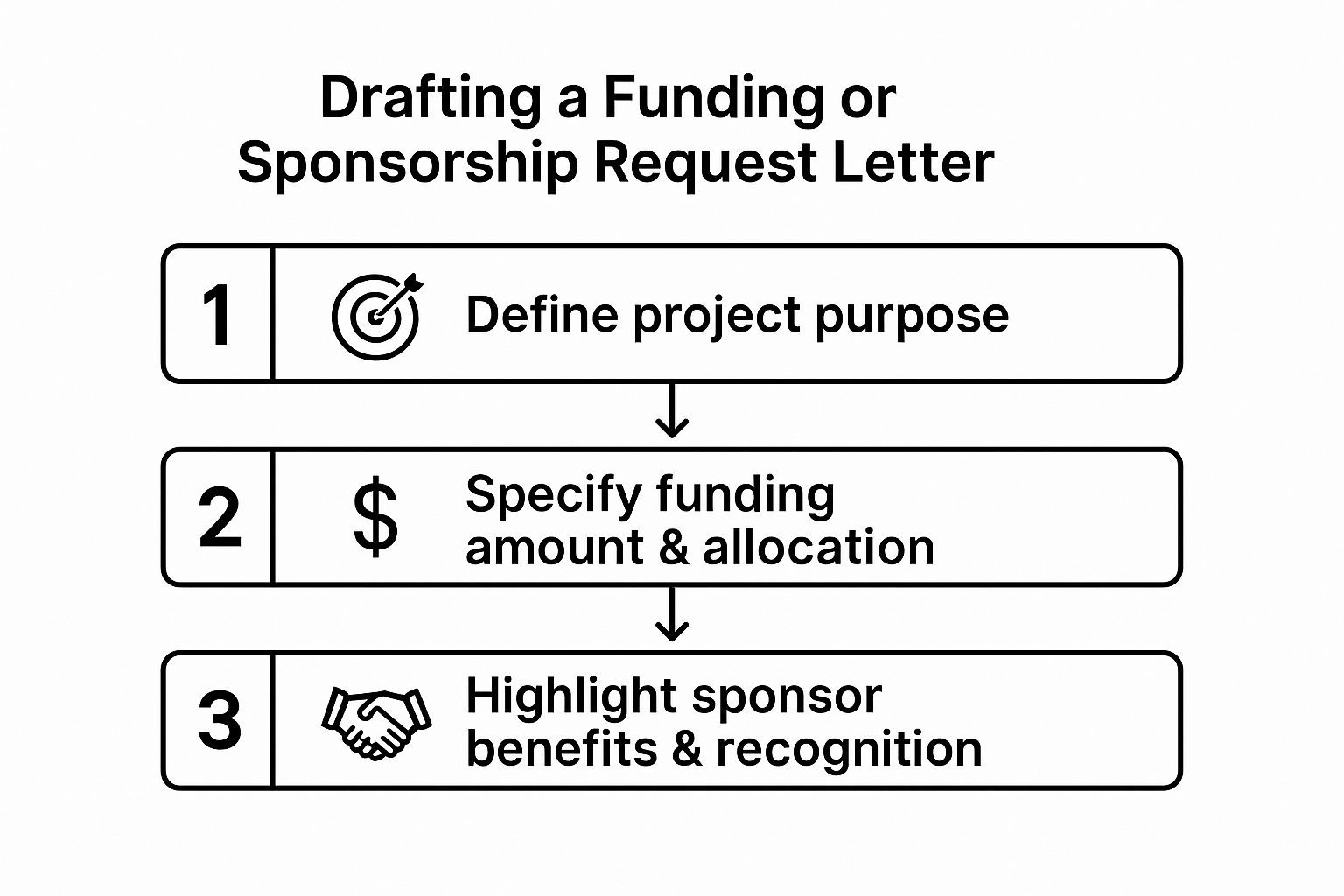
This visual guide shows that a successful letter starts with a clear purpose, specifies the exact financial need, and concludes by emphasizing mutual benefits. To further strengthen your proposal, explore comprehensive business proposal letter samples for additional insights.
Here are key strategies to implement:
- Research and Personalize: Thoroughly research potential sponsors to ensure their mission aligns with yours. Address the letter to a specific person and reference their organization's past projects or values.
- Lead with Impact: Start with a compelling story or a powerful statistic that clearly demonstrates the need or opportunity. This immediately grabs the reader's attention.
- Be Specific About Funds: Clearly state the exact amount of money you are requesting and provide a simple breakdown of how it will be allocated. Transparency builds trust.
- Highlight Sponsor Benefits: Outline the tangible benefits for the sponsor. This could include logo placement, public acknowledgment, tax benefits, or alignment with corporate social responsibility goals.
- Include Supporting Materials: Attach a brochure, impact report, or project proposal to provide more detail and credibility. Make it easy for them to learn more.
5. Permission Request Letter
A permission request letter is a formal document written to seek authorization or consent to perform a specific action. This is crucial when you need to use copyrighted material, access private property, or conduct activities that require approval from an authority figure or rights holder. This letter serves as a legal and professional courtesy, protecting both parties by clearly defining the scope of the permission granted.
The primary goal of this formal request is to be precise and transparent. You must clearly state what you are asking for, the context in which it will be used, and the duration of use. This demonstrates respect for ownership, policies, and legal rights, which is essential in educational, business, and creative fields.
When to Use This Letter
This type of formal request letter is necessary whenever you need to obtain official consent before proceeding with an action. It's a key step in avoiding legal issues and maintaining good relationships.
- Intellectual Property: Requesting to quote a large portion of a book, use a photograph in an article, or feature a trademarked logo in marketing materials.
- Property Access: Seeking permission from a landowner to film a movie, conduct a survey, or host an event on their property.
- Academic and Research: A student asking for approval to conduct research involving human subjects or a researcher requesting access to restricted archival documents.
- Parental Consent: A school sending a letter to parents to get permission for a child to participate in an off-campus field trip.
Actionable Tips for a Strong Request
A well-crafted permission request letter is clear, respectful, and provides all the necessary information for a decision-maker. Getting the details right from the start can prevent delays and increase your chances of getting a "yes." For more guidance on maintaining a professional tone, you can explore detailed resources on professional letter writing.
Here are key strategies to implement:
- Be Highly Specific: Clearly define what you want permission for. Instead of "use your photo," say "reproduce your photograph titled 'Sunset Over the Pier' on the cover of our monthly print magazine, with a circulation of 10,000."
- Explain the Context: Briefly describe your project and how the requested item or action fits into it. This helps the owner understand the purpose and scope of your request.
- Propose Acknowledgment: State how you will credit the owner. For example, "We will include a photo credit line reading ‘Photo by [Photographer’s Name]’ directly beneath the image."
- Submit Well in Advance: Do not wait until the last minute. Requesting permission can take time, especially if it involves legal review or negotiations, so plan accordingly.
6. Job Transfer or Relocation Request Letter
A job transfer or relocation request is a formal letter an employee writes to their employer to ask for a move to a different role, department, or office within the same company. This request is vital for employees seeking new challenges, aligning work with personal circumstances, or pursuing career growth within their current organization. It acts as an official document that clearly states the employee's intentions and reasoning.
The main purpose of this letter is to professionally present your case for the transfer. It should explain why you are requesting the move, highlight your continued commitment to the company, and articulate how the change benefits both you and the organization. A well-written request shows thoughtful planning and respect for the company's operational needs.
When to Use This Letter
This formal request letter example is appropriate when you want to change your professional scenery without changing your employer. It’s a key tool for internal mobility.
- Personal Relocation: Moving to be closer to family, for a spouse's job, or for other significant personal reasons.
- Career Development: Seeking a lateral move to a different department to gain new skills or experience.
- Internal Promotion: Applying for an open position at a different branch or in a higher-level role.
- Company Expansion: Requesting a transfer to a newly opened regional or international office.
Actionable Tips for a Strong Request
A strategic and professional approach is crucial for getting your transfer request approved. Your focus should be on clear communication, demonstrating value, and showing flexibility.
Here are key strategies to implement:
- Discuss It First: Before submitting the formal letter, have an informal conversation with your current supervisor. This shows respect and allows you to gauge their reaction and get advice.
- Emphasize Company Benefits: Frame your request around how the move will benefit the company. For example, mention how your skills are a perfect match for an understaffed team in the new location or how new experiences will make you a more valuable asset.
- Be Specific and Researched: Clearly state the desired position, department, or location. Show you have researched the role and understand its requirements, explaining how your qualifications align.
- Offer a Transition Plan: Propose a clear plan for handing off your current responsibilities. This demonstrates your commitment to a smooth transition and minimizes disruption for your team.
Formal Request Letter Types Comparison
| Letter Type | Implementation Complexity | Resource Requirements | Expected Outcomes | Ideal Use Cases | Key Advantages |
|---|---|---|---|---|---|
| Leave of Absence Request Letter | Moderate: requires clear dates, reason, and coverage plans | Employee time to prepare, possible supporting docs | Official HR documentation, approved absence | Personal, medical, family leave requests | Professionalism, protects employee rights, clear communication |
| Meeting Request Letter | Low to Moderate: specify purpose, agenda, timing | Minimal; scheduling info and contact details | Scheduled meeting, prepared participants | Business proposals, client meetings, reviews | Shows respect for time, improves meeting acceptance |
| Information Request Letter | Moderate: precise details, legal references if needed | Research on applicable laws, formal tone | Receipt of requested info, legal record | Data requests, research, legal inquiries | Creates official record, supports legal standing |
| Funding or Sponsorship Request Letter | High: detailed project info, budget, sponsor benefits | Time-consuming research and personalization | Funding or sponsorship secured | Nonprofits, events, research funding | Access to funds, builds relationships, professional presentation |
| Permission Request Letter | Moderate: clear description, use terms, legal considerations | Possible legal consultation | Authorized use, legal protection | Copyright, filming, trademark use, research | Prevents disputes, legal protection, fosters ethical conduct |
| Job Transfer or Relocation Request Letter | Moderate: justification, qualifications, transition plans | Time for self-assessment and negotiation | Approved transfer, career growth | Internal transfers, relocations | Supports career development, maintains employment continuity |
From Request to Result: Your Next Steps
We have walked through a comprehensive set of formal request letter examples, from requesting a leave of absence to seeking critical funding. Across these varied scenarios, a clear pattern emerges. A successful request is not merely about asking for something; it's a strategic act of communication built on a foundation of clarity, respect, and purpose.
The true power of this guide lies not in copying the examples verbatim, but in understanding the strategic architecture behind each one. Every letter, whether for a job transfer or simple information, is a tool designed to persuade, inform, and achieve a specific outcome. By internalizing these frameworks, you are no longer just filling in a template; you are engineering a positive response.
Core Principles for Effective Requests
As you move forward, keep these fundamental takeaways at the forefront of your writing process. These principles are the universal keys to unlocking a "yes."
- Clarity is King: Your recipient should understand your exact request, the reasons behind it, and any required actions within the first few seconds of reading. Ambiguity is the enemy of action.
- Contextualize Your Ask: Never assume the reader knows the full background. Briefly but effectively set the stage, explaining the "why" behind your request to build a case for its importance.
- Focus on the Recipient: Frame your letter from their perspective. How does granting your request benefit them, their team, or the organization? Highlighting mutual benefit can transform a simple ask into a compelling proposal.
- Professionalism is Non-Negotiable: A respectful tone, proper formatting, and a polished, error-free document signal that you are a serious professional who values the recipient's time and authority.
Your Action Plan for Mastering Formal Requests
Knowledge becomes power only when applied. Here are your next steps to translate the insights from these formal request letter examples into real-world results.
- Identify Your Next Request: Think about a request you need to make soon. It could be professional, like asking for a meeting with a senior manager, or personal, like requesting permission from a landlord.
- Deconstruct the Goal: Before writing a single word, clearly define your objective. What is the single most important outcome you need to achieve with this letter?
- Select and Adapt a Framework: Choose the example from this article that most closely aligns with your situation. Use its structure as your blueprint, but customize every detail to fit your specific context, audience, and goal.
- Review with a Critical Eye: Read your draft as if you were the recipient. Is the request immediately clear? Is the tone appropriate? Is there a compelling reason to say yes? Edit ruthlessly until the answer to all three is a confident "yes."
Mastering the art of the formal request letter is a career-long asset. It empowers you to advocate for your needs, create opportunities, and navigate complex professional landscapes with confidence and skill. Your next successful outcome is just one well-crafted letter away.
Ready to put these strategies into action without the guesswork? The AI Letter Generator uses the same principles of clarity, structure, and professional tone we've discussed to help you create perfectly tailored letters in seconds. Stop staring at a blank page and start communicating with confidence by visiting the AI Letter Generator.
